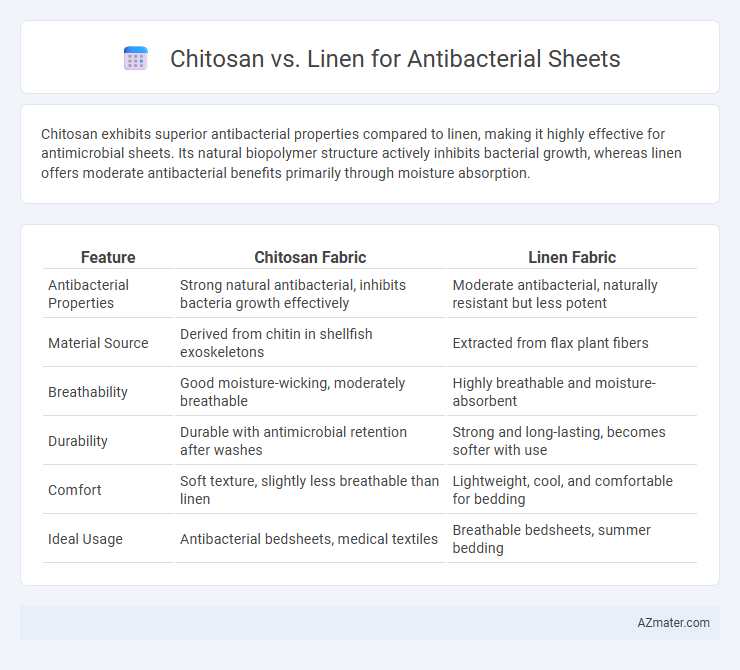Chitosan exhibits superior antibacterial properties compared to linen, making it highly effective for antimicrobial sheets. Its natural biopolymer structure actively inhibits bacterial growth, whereas linen offers moderate antibacterial benefits primarily through moisture absorption.
Table of Comparison
| Feature | Chitosan Fabric | Linen Fabric |
|---|---|---|
| Antibacterial Properties | Strong natural antibacterial, inhibits bacteria growth effectively | Moderate antibacterial, naturally resistant but less potent |
| Material Source | Derived from chitin in shellfish exoskeletons | Extracted from flax plant fibers |
| Breathability | Good moisture-wicking, moderately breathable | Highly breathable and moisture-absorbent |
| Durability | Durable with antimicrobial retention after washes | Strong and long-lasting, becomes softer with use |
| Comfort | Soft texture, slightly less breathable than linen | Lightweight, cool, and comfortable for bedding |
| Ideal Usage | Antibacterial bedsheets, medical textiles | Breathable bedsheets, summer bedding |
Introduction to Antibacterial Bedding Materials
Antibacterial bedding materials utilize advanced textiles like chitosan and linen to inhibit microbial growth and promote hygiene. Chitosan, derived from chitin in crustacean shells, exhibits strong antimicrobial properties and natural biocompatibility, making it a preferred choice for antibacterial sheets. Linen, a natural fiber from flax plants, offers breathability and inherent antibacterial effects, though its efficacy is generally lower compared to chitosan-treated fabrics.
Understanding Chitosan: Sources and Properties
Chitosan, derived primarily from the exoskeletons of crustaceans like shrimp and crabs, exhibits potent antibacterial properties due to its unique cationic nature that disrupts microbial cell membranes. Unlike linen, which is a natural fiber from flax plants with inherent breathability and moisture-wicking qualities, chitosan's molecular structure enables it to inhibit bacterial growth effectively. The biocompatibility, biodegradability, and film-forming ability of chitosan make it an optimal choice for antibacterial sheets targeting enhanced hygiene and skin health.
Linen: Natural Fiber with Antibacterial Qualities
Linen, a natural fiber derived from the flax plant, possesses inherent antibacterial qualities due to its dense fiber structure that inhibits bacterial growth and moisture accumulation. Compared to chitosan-coated sheets, linen offers breathability and hypoallergenic properties, making it ideal for sensitive skin and reducing potential irritations. Its durability and eco-friendly nature enhance its appeal as a sustainable choice for antibacterial bedding solutions.
Mechanisms of Antibacterial Action: Chitosan vs Linen
Chitosan exhibits antibacterial activity primarily through its positively charged amine groups that interact with negatively charged bacterial cell membranes, leading to membrane disruption and leakage of intracellular components. Linen's antibacterial properties are attributed to its natural phenolic compounds and fiber structure, which inhibit microbial adhesion and biofilm formation. Chitosan's mechanism provides stronger and broader spectrum antibacterial effects compared to linen, which relies more on passive antimicrobial barriers.
Effectiveness Against Common Bacteria
Chitosan exhibits potent antibacterial properties against common pathogens such as Staphylococcus aureus and Escherichia coli, making it highly effective for antibacterial sheets. Linen, naturally breathable and moisture-wicking, offers moderate antibacterial effects primarily due to its physical structure but lacks the bioactive components found in chitosan. Studies show chitosan-treated fabrics reduce bacterial growth significantly more than linen, enhancing hygiene and reducing odor in bedding applications.
Durability and Washability of Chitosan and Linen Sheets
Chitosan sheets exhibit superior antibacterial properties with enhanced durability due to their natural polymer structure, allowing them to maintain effectiveness over multiple washes without significant degradation. Linen sheets, crafted from flax fibers, offer high tensile strength and breathability but tend to weaken and lose antibacterial efficiency after repeated laundering. The chemical resilience of chitosan combined with its ability to retain antibacterial function through extensive wash cycles outperforms linen's mechanical durability and limited antibacterial longevity.
Comfort and Breathability: Textile Performance Compared
Chitosan-infused sheets exhibit superior antibacterial properties while maintaining excellent moisture-wicking and breathability due to their porous structure, enhancing overall comfort during sleep. Linen, known for its natural fiber breathability and thermal regulation, offers a cool, dry feel but lacks inherent antibacterial qualities without additional treatment. Textile performance testing shows chitosan sheets can balance antimicrobial efficacy with softness and airflow better than untreated linen, making them a preferred choice for hygienic, comfortable bedding.
Eco-Friendliness and Sustainability Factors
Chitosan exhibits strong antibacterial properties derived from natural crustacean shells, offering a biodegradable and renewable source that enhances eco-friendliness in antibacterial sheets. Linen, produced from flax plants, is highly sustainable due to low water usage, minimal pesticide application, and full biodegradability, making it an environmentally responsible textile choice. Both materials support sustainable production, but linen's cultivation impact tends to be lower, while chitosan's unique antimicrobial qualities provide added functional benefits in antibacterial applications.
Cost and Market Availability
Chitosan-based antibacterial sheets generally cost more than linen due to the complex extraction and processing methods involved in obtaining chitosan from crustacean shells. Linen sheets, derived from flax fibers, are widely available in the market and tend to be more affordable, making them a cost-effective option for antibacterial bedding. While chitosan offers superior antibacterial properties, its limited large-scale production impacts market availability compared to the more established and easily sourced linen fabric.
Which is Better? Summary and Final Recommendations
Chitosan exhibits superior antibacterial properties compared to linen due to its natural biopolymer structure that inhibits bacterial growth effectively. Linen offers breathability and durability but lacks inherent antimicrobial activity, making it less ideal for antibacterial sheets. For optimal antibacterial performance, chitosan-infused sheets are recommended, while linen suits users prioritizing comfort and eco-friendliness without strong antibacterial needs.

Infographic: Chitosan vs Linen for Antibacterial Sheet
 azmater.com
azmater.com